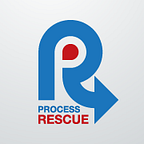Does introducing a new service feel like jumping overboard with concrete overshoes?
Many organisations I have worked with over the years have ended up with a nest of complex processes that I contend are totally unnecessary. These gradually begin to choke productivity until staff have lost sight of what the point of the process is. So the pressure comes on to introduce new ones. This is when you can feel like you’re jumping overboard with concrete overshoes!
Typically, in organisations beginning their journey, there is a drive to control every possible variable that might be thrown at us because then and only then we will be a truly well-managed organisation!
This is effectively like describing how to get to a destination on a map from every possible point of origin. Yes, it is possible, but is it useful? Probably not.
So, let’s deal with 4 of the most common complicators one at a time…
- Escalations are often used where a customer has received poor service. To my way of thinking, a staff member should be empowered to resolve the situation within a set of parameters agreed beforehand. To escalate this to a line manager as a routine event is disempowering to staff, infuriating to a customer and a drain on resources.
- Exceptions, even where valid, too many add little value. For example, an applicant is found to have a conflict of interest in a recruitment process. To create alternate flows to allow this to be dealt with is not worth the effort because it effectively legitimises that path. Far better to provide accurate criteria upfront so that they can either resolve it before applying or not waste their time and ours.
- Quality assurance is where someone checks the quality of work produced for errors. It seems reasonable to expect a lift in the quality of the products and services from this. Until you stop to consider the humans in our lives! What inevitably happens is that QA becomes a safety blanket to catch sloppy work and does so successfully attracting more resources to keep doing so based on the ‘near misses’. When the pressure comes on, other staff just ‘get it done’ and hope for the best. My challenge to such an organisation would be to fix the problems generating the poor quality! For example, manage the workload so that there are enough staff to cover the peaks. Or even better try to smooth the demand so that workload is more predictable for resourcing.
- Approvals are of course often necessary, especially where finances and legislation are involved, but I would encourage close scrutiny to identify the unnecessary ones. They are often more about ‘I want to know what’s going on’ than needing a control mechanism. Remove these and replace with a notification or a self-service report. This will decrease the time spent waiting to go to the next step. It really is surprising how common this is! Where control really is needed, you could try to document the rules and empower one actor with making the decision on behalf of everyone else based on agreed rules (this could be a person or a system actor).
My advice to clients is to eliminate or minimise these complicators from your processes wherever possible! It isn’t necessarily easy for those inside an organisation to see these problems, so be prepared to bring in some external help.
